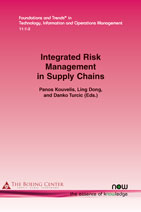A Cournot-Stackelberg Model of Supply Contracts with Financial Hedging and Identical Retailers
By René Caldentey, Booth School of Business, The University of Chicago, USA, Rene.Caldentey@chicagobooth.edu | Martin Haugh, Imperial College Business School, UK, m.haugh@imperial.ac.uk
Abstract
We study the performance of a supply chain where N retailers and a single producer compete in a Cournot-Stackelberg game. We assume the retailers are budget-constrained and their profits depend on the realized path of some tradeable (stochastic) economic index. The supply chain might therefore be more profitable if the retailers were able to reallocate their budgets across different states of nature. In order to affect such a reallocation, we assume the retailers are able to trade dynamically in the financial market. We solve the Cournot-Stackelberg equilibrium when the retailers have identical budgets and study the impact that competition and hedging have on the supply chain and on the various players including the firms themselves, the end consumers and society as a whole. We show, among other things, that when the retailers can hedge there exists an optimal level of competition, ¯N , that is often finite and optimal from the perspective of the consumers, the firms and society as a whole. In contrast, when the retailers cannot hedge, these welfare measures are uniformly increasing in N.
Integrated Risk Management in Supply Chains
Integrated Risk Management in Supply Chains examines supply chain risk management. The increased interest in the topic is due to a number of factors including the increased volatility of commodity prices and exchange rates, recent natural disasters, and the increased importance of multinational corporations. The motivation for risk management comes from a variety of sources: financial distress costs, managerial incentives, and other important reasons discussed in the remainder of this book. Understanding the motives is important because they provide insights into which risks should be managed and how a firm’s risk management operations should be organized.
The first part examines Buffering Supply Chain Risk with Operational Flexibility and deals with uncertainty in the form of routine variability, which includes fluctuations in demand. Part 2 reviews Supply Disruption. Both the preponderance of natural disasters and huge economic swings can cause extreme challenges across the supply chains. Although these types of risks are rare, they are highly consequential and buffering is insufficient to mitigate them. Instead, firms facing these risks must engage in contingency planning and must maintain redundancies in the system. This is why contingency planning is on the interface of operations and finance. Part 3 looks at Commodity Price Risks, which includes five papers on managing price risks – the first three papers are fundamental in that they ask “when” and “how” firms should manage price risks with hedging and how hedging affects operating policy and the remaining two papers examine the best practices in specific industries.

Companion
Foundations and Trends® in Technology, Information and Operations Management, Volume 11, Issue 1-2 Special Issue: Integrated Risk Management in Supply Chains
See the other articles that are also part of this special issue.